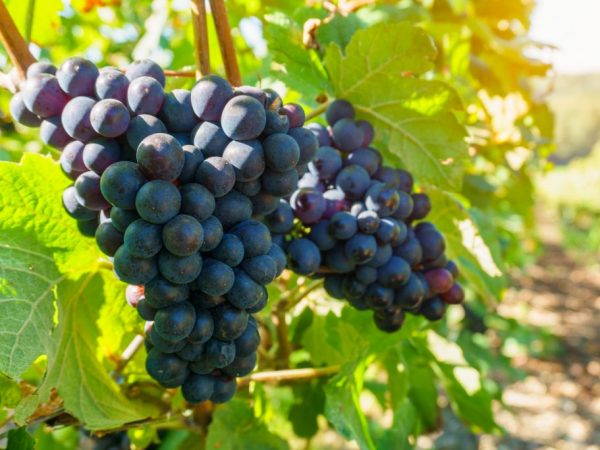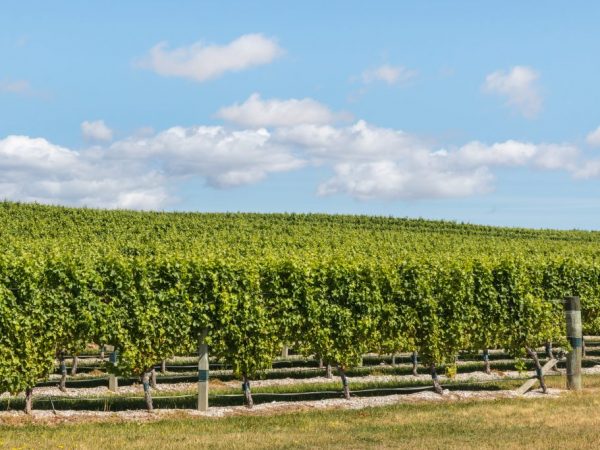Growing grape varieties of Potapenko selection
Potapenko grape varieties have many advantages. This variety belongs to the early ones, it is resistant to temperature extremes, therefore it is suitable for growing in all regions of the country.

Growing grape varieties of Potapenko selection
Amur variety
Potapenko Amur grape variety is resistant to frost down to -40 ° С. The bushes reach a height of 5-6 m. The leaf plate is of moderate size, without cuts and roughness. The leaf color is dark green. The inflorescences are bisexual.
Description of the fruit:
- medium-sized berries, up to 18 g;
- the peel of a delicate purple hue, dense;
- seeds are available in small quantities and do not affect the state of taste;
- clusters are large, conical;
- the weight of an individual bunch is 700-800 g;
- the yield is good: up to 10 kg are harvested from the bush during the season.
Gold grade
The bushes of this Potapenko table grape are tall, reaching 5 m. The leaves are large, dark green in color. Flowering occurs with bisexual inflorescences, which increases productivity. The characteristics of this variety indicate that it is resistant to fungal infections and is rarely affected by bacteriosis.
The description indicates the size of the berries and bunches of the Gold variety. The average weight of a berry is 5 g. Bunches grow up to 1 kg. The color of the peel is rich yellow, which brings a certain contrast to the garden. The taste is pleasant, sweet. The seeds are small, therefore they do not affect the taste of the fruit.
Triumph variety
This variety belongs to the products of early selection. The first harvest is in early August. Bushes are tall, up to 6 m. According to the description, Triumph nutmeg has light green leaves without cuts or lobes. The structure of the leaf plate is smooth, without roughness and wax deposits. The flowers are predominantly female, but this does not prevent this grape variety from being characterized by high yields.
Berries are bright yellow large, weight 2-4 g. Bunch weight 900-1200 g. Pleasant sweet taste is noted.
Features of planting and growing
Planting is carried out in the middle of spring, when the sun begins to shine actively. Saplings should be planted in sunny, elevated areas so that fruiting occurs much earlier. The depth of groundwater is 2-3 m from the surface. Seedlings are bought in advance and stored in containers, since the root system of these grape varieties is not spreading, it is allowed to plant in a container, removing the bottom in advance.

Plants need sunlight
It is better to cook the hole in the fall. To do this, dig a hole 70x80 cm in size.A drainage system is installed inside, sprinkle it with a bucket of humus. This will help the soil to be nourished with useful elements during the winter.
In the spring, seedlings are placed in the hole and sprinkled with a fertile top layer of earth. At the end of planting, watering is carried out, 20 liters of warm water are used and a metal support is installed. A bush is tied to it so that it does not deform.
Culture care
It is not difficult to look after the varieties of Potapenko's selection, since they need a standard procedure.Water the plants at intervals of 10 days using water at room temperature. After watering, the topsoil is loosened and weeds are removed. This will ensure that the roots receive the maximum amount of air and nutrients.
Top dressing is carried out in several stages. You need to start applying fertilizers from the next year, after planting. In spring, grape plants need potassium fertilizers. To do this, a solution of potassium nitrate is poured under the root (10 g per 2 liters of water). 15 liters of solution are poured under one bush. In July, plants need nitrogen substances. One bush has 20 liters of ammonium nitrate solution (20 g per 10 liters of water). In the fall, to prepare for winter, it is covered with agrofibre, and the soil around is mulched with a mixture of humus and straw.
Pruning is carried out so that no more than 8 eyes remain on the shoots. All diseased areas of the bush are removed so that the plant will recover and bear fruit much better.
Pest and disease control
The advantage of varieties is that they are rarely affected by diseases. More often they are affected by root rot or powdery mildew, which are associated with poor-quality care. Following the rules of care will help prevent the appearance of these diseases. It is impossible to get rid of root rot. In the end, you still have to uproot the plant. A solution of Bordeaux liquid (2 g per 10 l of water) saves from powdery mildew.
Fleas, wasps and birds are considered common pests. Special covering materials (nets or fabric) help to fight birds. Traps using sweet substances will allow you to get rid of wasps. A manganese solution (2 g per 5 l of water) will save the culture from the invasion of a flea.
Conclusion
Potapenko varieties are characterized by a large number of advantages. It is not difficult to grow them, so even beginners can do gardening. If you adhere to all the rules for planting and caring, from next year you will enjoy high-yielding, good quality products.
The fruits of these varieties are suitable for long-term storage and do not crack during transportation, and the use of these berries helps to improve the state of memory.


